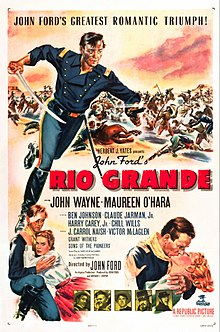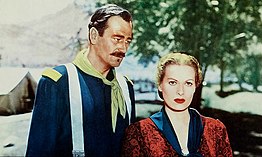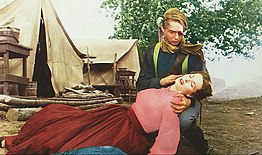| Rio Grande | |
|---|---|
 Theatrical poster | |
| Directed by | John Ford |
| Screenplay by | James Kevin McGuinness |
| Based on | Mission With No Record 1947 story Saturday Evening Post by James Warner Bellah |
| Produced by | Uncredited: Merian C. Cooper John Ford |
| Starring | |
| Cinematography | Bert Glennon |
| Edited by | Jack Murray |
| Music by | Victor Young |
Production companies | |
| Distributed by | Republic Pictures |
Release date |
|
Running time | 105 minutes |
| Country | United States |
| Language | English |
| Budget | $1,214,899[1][2] |
| Box office | $2.25 million (US rentals)[3] |



Rio Grande is a 1950 American romantic Western film[4][5] directed by John Ford and starring John Wayne and Maureen O'Hara. It is the third installment of Ford's "Cavalry Trilogy", following two RKO Pictures releases: Fort Apache (1948) and She Wore a Yellow Ribbon (1949).[6] Wayne plays the lead in all three films, as Captain Kirby York in Fort Apache, then as Captain Nathan Brittles in She Wore a Yellow Ribbon, and finally as a promoted Lieutenant Colonel Kirby Yorke in Rio Grande.[a] Rio Grande's supporting cast features Ben Johnson, Claude Jarman Jr., Harry Carey Jr., Chill Wills, J. Carrol Naish, Victor McLaglen, Grant Withers, the Western singing group the Sons of the Pioneers and Stan Jones.
In the film, Yorke leads a cavalry regiment at the border of Texas and Mexico. He has been estranged from his wife Kathleen and son Jeff for the last fifteen years. Jeff recently flunked out of military school and enlisted as a private. He comes under Yorke's command, where Yorke promises not to give him special treatment. Kathleen soon arrives at the fort, trying unsuccessfully to get Jeff to return to military school. As Kathleen and Yorke deal with their son, their relationship revives. Meanwhile, Apaches have been attacking the fort and taking refuge in Mexico so that Yorke's regiment can't retaliate against them. After an attack on the fort's women and children where the children are kidnapped, Yorke pursues Apache raiders into Mexico and raids their villages with permission from his general. He saves the kidnapped children, and returns to Kathleen settling into her role as military wife on the fort.
While originally Ford was uninterested in directing another Western, his studio wouldn't permit him to start The Quiet Man until he directed Rio Grande. The script was based on a short story by James Warner Bellah, which was inspired by historical events. The film was shot in only 32 days in Monument Valley, Utah. After its release, it made a modest profit, with reviewers praising the music and the action, but noting that the themes were well-worn. Later reviews praised the natural beauty of the shooting location, but were mixed about its efficacy. The film can be read as anticipating the frustration with international borders the US military would experience in the Vietnam War, with the solution to ignore international borders reflecting the conservative politics of Bellah and scriptwriter James Kevin McGuinness. The film is one of the least sympathetic of Ford's Westerns to Native Americans, depicting them as bloodthirsty and villainous. In contrast to its one-sided portrayal of Native Americans, its treatment of the reconciliation of an estranged couple and their son is emotionally complex. Rio Grande also addresses issues of class, showing a rejection of class privilege common in Ford's work.
- ^ Flynn, Charles; McCarthy, Todd (1975). "The Economic Imperative: Why Was the B Movie Necessary?". In Flynn, Charles; McCarthy, Todd (eds.). Kings of the Bs: working within the Hollywood system: an anthology of film history and criticism. E. P. Dutton. p. 30.
- ^ Cite error: The named reference
waynewas invoked but never defined (see the help page). - ^ 'The Top Box Office Hits of 1950', Variety, January 3, 1951
- ^ Cite error: The named reference
varietywas invoked but never defined (see the help page). - ^ Harrison's Reports film review; November 4, 1950, page 176.
- ^ Wetta and Novelli 2006, p. 299.
- ^ Wetta and Novelli 2006, p. 315.
Cite error: There are <ref group=lower-alpha> tags or {{efn}} templates on this page, but the references will not show without a {{reflist|group=lower-alpha}} template or {{notelist}} template (see the help page).